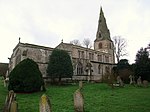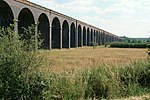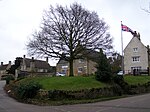Welland Viaduct

Welland Viaduct, Harringworth Viaduct or Seaton Viaduct, crosses the valley of the River Welland between Harringworth in Northamptonshire and Seaton in Rutland, England. The viaduct is 1,275 yards (1.166 km) long and has 82 arches, each with a 40 feet (12 m) span. It is the longest masonry viaduct across a valley in the United Kingdom. Built by the contractor Lucas and Aird, a total of 30 million bricks were used in the viaduct's construction. Completed during 1878, it has since become a Grade II listed building.The Welland Viaduct is on the Oakham to Kettering Line between Corby and Manton Junction, where it joins the Leicester to Peterborough line. The line is generally used by freight trains and steam specials. In early 2009, a single daily return passenger service was introduced by East Midlands Trains between Melton Mowbray and St Pancras via Corby, the first regular passenger service to operate across the viaduct since the 1960s. There are now two return services between Melton Mowbray and London St Pancras each weekday. The viaduct is on a diversionary route for East Midlands Railway using the Midland Main Line route.
Excerpt from the Wikipedia article Welland Viaduct (License: CC BY-SA 3.0, Authors, Images).Welland Viaduct
Seaton Road,
Geographical coordinates (GPS) Address External links Nearby Places Show on map
Geographical coordinates (GPS)
| Latitude | Longitude |
|---|---|
| N 52.566944444444 ° | E -0.65388888888889 ° |
Address
Welland Viaduct (Harringworth Viaduct)
Seaton Road
LE15 9HZ , Harringworth
England, United Kingdom
Open on Google Maps








